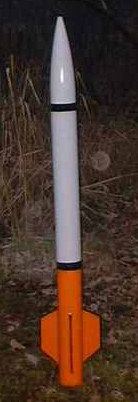| Manufacturer: | Yank Enterprises |

(Contributed - by David Urbanek)
Courtesty of Yank Enterprises
Brief:
Basic 3" rocket with a different look and good flight characteristics. I
modified this to accept either a RATT works H70 (with electronics) or a baffle.
I'll explain my modifications below.
Construction:
Yank Enterprises kits have superior quality components. The nose cone is a
standard LOC 3" nose cone. The body tube is a single 36" length of
phenolic tube. The three fin slots are already cut, but the ends are round,
you'll have to file them square. The outside diameter of the tube is larger
than the nose cone base. This is fine for me, but it will drive some folks
absolutely bonkers. Motor mount is a 12" length of 1.14" phenolic
tube and the kit comes with 2 very good centering rings. No motor retention is
provided so I would suggest getting whatever you'll use before you start
building. I used a single 10/24 blind T nut and a screen door clip. A shock
cord of 5/16" tubular nylon (pink, no less) is provided as well as very
sturdy anchoring bolts. Good launch lugs too, but I use BlackSky rails in all
my rockets now. Finally the 'chute was made of very slick nylon and was dark
blue in color.
The instructions are sufficient if you've built high power rockets. I think a "neo" would make some wrong assumptions in a number of places with these instructions, so it's really a kit for someone with at least 1 high power rocket under their belts. The order in which I built the rocket was first to wrap the body tube with 1 layer of 1.4 oz fiberglass to harden the surface and fill the spiral. While that set up I attached the forward centering ring to the motor mount tube as per instructions. I then mounted the motor mount, with the aft centering ring slip fitted. Then I attached the fins through the slots. After applying fillets inside the rocket, I attached the aft centering ring (with T-Nut). This made for a very sturdy mount, so I didn't apply external fillets. I also left the fins squared off. It adds drag, but to me, it looks right.
While I was building this model, I bought a RATT works H70 hyrbid and decided that the Genesis would be it's first recipient. This required an altimeter bay and venting for the motor, but I also wanted to fly conventionally with a baffle. I cut the body tube 15" from the front of the body tube. I made a baffle/electronics bay out of a 6" long 3" coupler tube. A centering ring is fastened to the aft of this coupler and two threaded rods run up the side (about 1/4" in from the edge). Then I made a two couplers that slip fit inside this coupler. One will work as and altimeter bay. A Pratt G-Wiz Deluxe fits in side. A bulkhead with a recovery system attach point tops off the altimeter bay. When I use the baffle, the vent hole for the altimeter is covered.
Without my modifications, this would be a great rocket. It's unusual lines, nice size, and straight forward constuction makes it a very good rocket.
Download RockSim file(s) Genesis with Baffle or Genesis with RATT!
Finishing:
I'm still in the middle of finishing. It's currently too cold in Utah to finish
painting. When finished, my Genesis will sport Miami Dolphin teal and orange
with variations of the Dolphins logo made from stick on mono-kote.
Construction Rating: 4 out of 5
Flight:
I've flown this rocket 4 times now, all with an altimeter on board to find out
what the Cd of the rocket is. It appears that with no external fillets and
squared fins, the Cd is between 0.95 and 1.05. The rocket is a bit
under-powered with a 29mm mount if you have a big field. However, the flights
have been universally straight and true. G motors don't break 1000', H128 puts
it up about 1400' and and H180 will get it up around 2000'. If I had it to do
over again, I would have installed a 38mm mount and adapted down to 29 mm when
I wanted it to land close. The rocket shows little or no tendency to
weathercock. Even with the slow lift off prodided by the G64, it did not bend
into the wind and was recovered close to the pad. If you're flying amongst
trees, this is an excelent design with few protuberances to catch on limbs.
Recovery:
If you are flying near sea level over soft ground, the heavy construction and
smallish 'chute will bring the rocket back fast. Here, in the west, I fly over
had desert playa, dry lake beds and stony ground. I think a 42" chute
would be more appropriate. The tail end of my Genesis is starting to show some
wear.
Flight Rating: 4 out of 5
Summary:
The Genesis is an excellent design. It looks different, flies very well and is
sturdy and strong. Within this kit is a lot of potential. Besides building it
scratch, the high quality components are a good starting point for
modifications. If you're thinking of a kit that would be fun to 'try things on'
I would recommend this kit.
Overall Rating: 4 out of 5
 |
 |
Flights
Sponsored Ads
 |
 |

![Zank Me Yank Me Crank Me [Explicit] Zank Me Yank Me Crank Me [Explicit]](https://m.media-amazon.com/images/I/51VQAh6GrKL._SL500_.jpg)


![Yanks [DVD] Yanks [DVD]](https://m.media-amazon.com/images/I/51+CdnXk4eL._SL500_.jpg)






